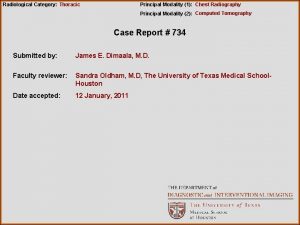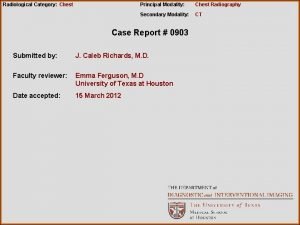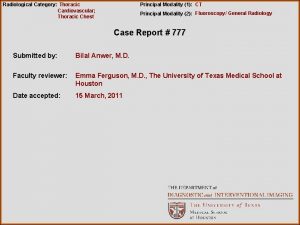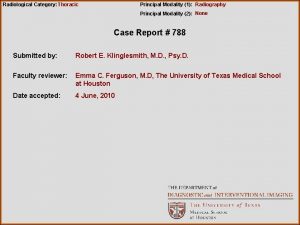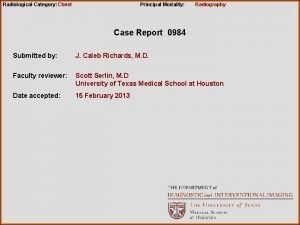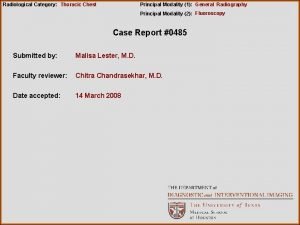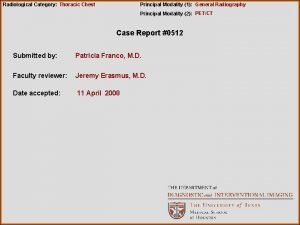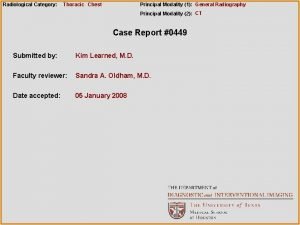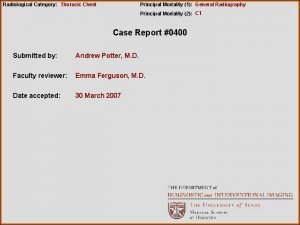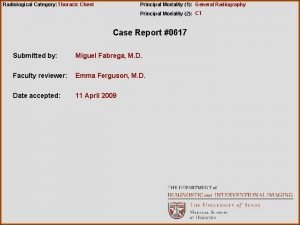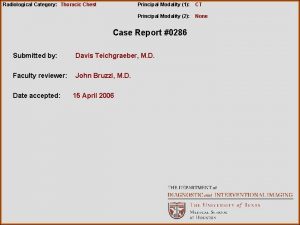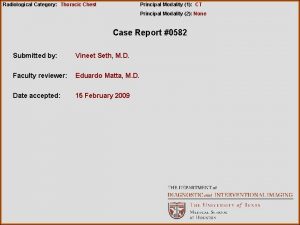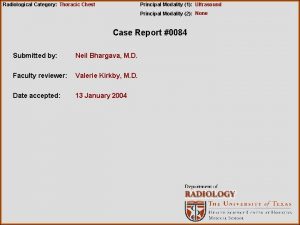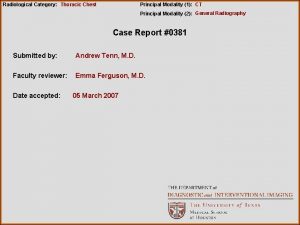Radiological Category Thoracic Principal Modality 1 Chest Radiography
















- Slides: 16

Radiological Category: Thoracic Principal Modality (1): Chest Radiography Principal Modality (2): Computed Tomography Case Report # 734 Submitted by: James E. Dimaala, M. D. Faculty reviewer: Sandra Oldham, M. D, The University of Texas Medical School. Houston Date accepted: 12 January, 2011

Case History Patient is a 64 year old male with history of osteoporosis and multiple prior vertebroplasties.

Chest X-ray August 2010

Axial Contrast-enhanced Chest CT Images in Mediastinal/Bone Windows of a Patient With Similar Findings and History Pelton W, Kirsch J, Candocia F, Allen B, Bhalla S, Mohammed TL. Methylmethacrylate Pulmonary Emboli: Radiographic and Computed Tomographic Findings. J Thorac Imaging 2009; 24: 241 -247

Test Your Diagnosis Which one of the following is your choice for the appropriate diagnosis? After your selection, go to next page. • Calcified metastases • Silicosis • Post-infectious calcified nodules • Methylmethacrylate pulmonary emboli

Chest X-ray from 2 years prior

Status post vertebroplasty 1 year prior to thoracic spine posterior fusion

Additional History Additional patient history reveals no prior occupational exposures, infectious exposures, or recent travel. Patient does not have a known primary or metastatic malignancy.

Findings and Differentials Findings: - Multiple bilateral high density linear and punctate opacities - CT demonstrates high attenuation densities within the segmental and subsegmental pulmonary arteries bilaterally. - Bilateral pleural effusions and left retrocardiac atelectasis and/or consolidation - Thoracic spine posterior fusion hardware with lower thoracic spine vertebroplasty - Osteopenia Differentials: • Post-infectious calcified nodules • Calcified metastases • Methyl-methacrylate pulmonary emboli

Discussion Methylmethacrylate pulmonary emboli (MMPE) appear as high density tubular branching densities on chest radiography which localize to the pulmonary arteries on CT. The mechanism involves leakage of this material into the paravertebral venous system, with subsequent embolism to the SVC or IVC and pulmonary arterial tree in patients with prior vertebroplasty. The rate of pulmonary embolism in this population is not known, however, up to the 24% of patients may have leak into adjacent paravertebral veins post-procedure, with these patients at increased risk of subequent pulmonary embolism 2. Patients are usually asymptomatic in spite of cement pulmonary emboli upon discovery, however, symptoms and sequela include chest pain, shortness of breath, leg swelling, hypotension and arrhythmias 4. In addition, a single case report documents a patient who developed a large cement saddle embolus and subsequent right heart failure necessitating embolectomy 2. Few case reports state treatment can be surgical, i. e. embolectomy as noted above. Anticoagulation has been suggested as a means to reduce thrombus formation on the surface of the embolized cement material, although evidence to support this is largely lacking 4. Methylmethacrylate material has extravasated out of the vertebral body into the prevertebral vein with subsequent drainage into the IVC. Pelton W, Kirsch J, Candocia F, Allen B, Bhalla S, Mohammed TL. Methylmethacrylate Pulmonary Emboli: Radiographic and Computed Tomographic Findings. J Thorac Imaging 2009; 24: 241 -247

Axial Noncontrast Chest CT Images in Mediastinal Windows of Patients With Similar Findings and History Pelton W, Kirsch J, Candocia F, Allen B, Bhalla S, Mohammed TL. Methylmethacrylate Pulmonary Emboli: Radiographic and Computed Tomographic Findings. J Thorac Imaging 2009; 24: 241 -247

Discussion The differential diagnosis for diffusely scattered high density nodules on chest radiography or computed tomography includes calcified metastases, sequela of prior infection, occupational exposure, and iatrogenic causes such as methylmethacrylate pulmonary emboli from vertebroplasty. Calcified metastatic malignancy is the most worrisome of the differential and can be seen with osteosarcoma, chondrosarcoma, synovial sarcoma, giant cell tumor of the bone, thyroid carcinoma, mucinous adenocarcinoma, or treated choriocarcinoma metastases 1. Further imaging is usually required to rule out one of these primary causes. Although calcified metastases should be a serious consideration in this patient, the interval development of tubular densities in the setting of prior vertebroplasty is more suggestive of methylmethacrylate pulmonary emboli. Osteosarcoma metastases Marchiori E, Souza A, Franquet T, Muller N. Diffuse High-Attenutation Pulmonary Abnormalities: A Pattern-Oriented Diagnostic Approach on High-Resolution CT. AJR 2005; 184: 273 -282

Post-infectious Calcified Nodules Postinfectious calcified nodules can be seen in patients with prior tuberculosis, fungal (i. e. histoplasmosis), or viral infections. The nodules are usually 2 -5 mm in diameter and accompanied by calcified hilar or mediastinal lymph nodes and parenchymal scarring/distortion in the setting of prior tuberculosis or histoplasmosis infection 1. Widespread tiny calcified pulmonary nodules without evidence of adenopathy are seen as an uncommon sequela of varicella pneumonia 1. Our patient with MMPE had no known infectious exposures. No calcified mediastinal or hilar lymphadenopathy was noted. Again, patient history and the temporal relationship of the findings following vertebroplasty are key to the diagnosis. Residual Varicella Infection Post-primary TB Marchiori E, Souza A, Franquet T, Muller N. Diffuse High. Attenutation Pulmonary Abnormalities: A Pattern-Oriented Diagnostic Approach on High-Resolution CT. AJR 2005; 184: 273282

Silicosis A wide spectrum of pulmonary findings are seen with silicosis including 1 -3 mm round calcified or noncalcified nodules with an upper lobe predilection, progressive massive fibrosis, and hilar/mediastinal adenopathy with egg-shell calcifications. The pathologic mechanism involves inhalation of silica dust from occupational exposures, i. e. miners. The high density nodules in our patient are more tubular than micronodular, and are randomly scattered throughout the lungs without a zonal distribution. In addition, no hilar or mediastinal lymphadenopathy was identified. Progressive massive fibrosis containing multiple puncate calcifications. Marchiori E, Souza A, Franquet T, Muller N. Diffuse High-Attenutation Pulmonary Abnormalities: A Pattern-Oriented Diagnostic Approach on High-Resolution CT. AJR 2005; 184: 273 -282

Diagnosis Methylmethacrylate pulmonary emboli

References 1. Marchiori E, Souza A, Franquet T, Muller N. Diffuse High-Attenutation Pulmonary Abnormalities: A Pattern-Oriented Diagnostic Approach on High-Resolution CT. AJR 2005; 184: 273 -282 2. Choe D, Marom E, Kamran A, Truong M, Madewell J. Pulmonary Embolism of Polymethyl Methacrylate During Percutaneous Vertebroplasty and Kyphoplasty. AJR 2004; 183: 1097 -1102 3. Padovani B, Kasriel O, Brunner P, Pertti-Viton P. Pulmonary Embolism Caused by Acrylic Cement: A Rare Complication of Percutaneous Vertebroplasty. AJNR March 1999; 20: 375 -377 4. Pelton W, Kirsch J, Candocia F, Allen B, Bhalla S, Mohammed TL. Methylmethacrylate Pulmonary Emboli: Radiographic and Computed Tomographic Findings. J Thorac Imaging 2009; 24: 241 -247 Images from Marchiori et al. are used with the permission of the copyright owner, American Roentgen Ray Society. Images from Pelton et al. are used with the permission of the copyright owner, Wolters Kluwer Health.
 Erate category 1
Erate category 1 National radiological emergency preparedness conference
National radiological emergency preparedness conference Radiological dispersal device
Radiological dispersal device Tennessee division of radiological health
Tennessee division of radiological health Center for devices and radiological health
Center for devices and radiological health Cardinality and modality
Cardinality and modality Modality erd
Modality erd Tom arbuthnot
Tom arbuthnot Epistemic modality
Epistemic modality Diagnostics imaging
Diagnostics imaging What is modality in statistics
What is modality in statistics Modality
Modality Modality in software engineering
Modality in software engineering Entity class in software engineering
Entity class in software engineering Epistemic modality
Epistemic modality Modality in software engineering
Modality in software engineering Data modeling fundamentals
Data modeling fundamentals

















